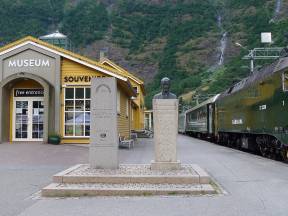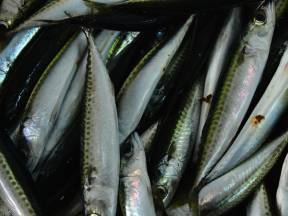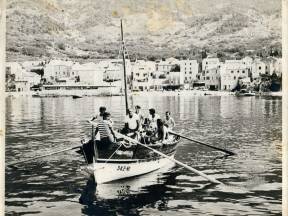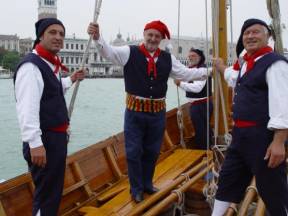Indoor

Flåm Railway Museum
Welcome to the Flåm Railway Museum Press the red download button, then tap on the interest points below, as you follow the route around the museum. With a pleasant narration, you will hear about the construction of the Flåm Railway and the history of Flåm. At your own pace, on your own mobile, you will get to know the authentic exhibition at the museum. LANGUAGES: -Du kan endre språk ved å trykke på den lille knappen oppe til høyre. -You can change to your preferred language by pressing the small button up to the right. -Sie können Ihre bevorzugte Sprache ändern, indem Sie auf den kleinen Button oben rechts drücken. -Vous pouvez changer pour votre langue préférée en appuyant sur le petit bouton en haut à droite. -您可以通过按右上方的小按钮来切换到您喜欢的语言。 -Puede cambiar a su idioma preferido presionando el pequeño botón ubicado arriba a la derecha. -右上の小さなボタンを押すことで、お好みの言語に変更することができます。 -Puoi cambiare alla tua lingua preferita premendo il piccolo pulsante in alto a destra. -우측 상단에 있는 작은 버튼을 눌러 원하는 언어로 변경할 수 있습니다.

Hotell Refsnes Gods - En historisk vandring
Refsnes Gods har vært preget av gjestfrihet siden slutten av 1700-tallet, og du er med det på vei inn i en over 250 år gammel historisk vandring. Gjestfrihet hos oss i dag omfatter god mat, vin og service - pakket inn i en historisk sus av både klassiske og moderne kunstutrykk. De fleste ønsker å ha mer tid til å gå på kunstutstillinger. Hos oss kan du kombinere et hotellbesøk med en kunstopplevelse i våre møterom, restaurant, bar, salonger, i tillegg til at alle bor i sitt eget lille «galleri». Hotellet representerer i dag nærmere 500 kunstverk av 90 kunstnere. Nyt denne audioguiden i ditt eget tempo og lær mer om historien og kunstverkene. God vandring ønskes av hotellets direktør og medarbeidere.

Traditional Komiža dishes
Dalmatian cuisine has always been a combination of sea, land and simple ingredients that are transformed into dishes rich in flavor and story. It smells of the sea in brudet, the warmth of home in Komiža pogača and the sweet festivity in Komiža cviti. Brudet is a dish of fishermen and farmers, born from the need to turn every catch into a delicious meal, while Komiža pogača speaks of togetherness and work around the table, when the dough is filled with salted sardines, onions and tomatoes. Cviti, on the other hand, bring a festive tone, because these crispy cookies are baked on special occasions and passed down from generation to generation as a sign of care and love. Together, the three recipes reveal the spirit of the island and the coast: simplicity, modesty, but also the richness of flavor that is created when tradition and nature come together on a plate.

Aurland Shoe Factory
Welcome to Aurlandsskoen and the Aurland shoe factory. During this tour you will gain an insight into the history behind the iconic Aurland shoe, the creators behind the «original penny loafer» and the reason as to why there is a 10 øre coin in the shoe. When you have learnt about the history of the shoes, you can head down to the factory and get a glimpe of how the shoes are made. All customers who have used the audio guide will get a 10% discount on products in the store. Just notify one of the workers on the till that you have used the audio guide app. If you are staying overnight at one of our hotels, Fretheim Hotel, Hotel Aurlandsfjord, Heimly or Myrkdalen Hotel, you will receive a 15% discount on products. Please show your booking confirmation or room key to obtain the discount.

Aurlandskoen intro
The Aurland shoe factory museum has plenty of interesting stories to tell you. More information is given at the museum. Read more here: https://www.norwaysbest.com/things-to-do/food--culture/aurlands-guided-tour/ Les mer her: https://www.norwaysbest.com/no/ting-a-gjore/mat-og-kultur/aurlands-guided-tour/ Lesen Sie hier mehr: https://www.norwaysbest.com/de/aktivitaten/essen-und-kultur/aurlands-guided-tour/

Komiža fishermen - conquerors of the world's seas
From the small town of Komiža, a fishing village on the island of Vis, came people who have left their mark on the world's fishing history. Nikola Martinis - Fishman was the first to bring the spirit of innovation to America, creating the foundations of modern fishing. His fellow countryman Paul Martinis made his name in the cold waters of Alaska and the Aleutians, where he became the legendary "Salmon King", personally decorated by American President Eisenhower. Ivan Žuanić, an immigrant to Washington at the beginning of the 20th century, began building a fleet in San Pedro that would grow into the largest fishing force in the world, and his heirs turned the family tradition into the powerful "Zi Company". The pinnacle of this dynasty is Lawrence Zuanich, who in the 1980s commanded a fleet of thirteen tuna vessels and annually caught one hundred thousand tons of tuna - as much as thirty-fifths of the world's catch. His most loyal collaborator was Ante Dundov Kongo with his Kaljani, without whom this fishing empire would not have been possible. From Fishman to the Salmon King, from San Pedro to Guam, the people of Komiža have shown with their knowledge, courage, and tireless work that even a small town can produce the world's greatest fishermen.

Historical events
Located on the western part of the island of Vis, Komiža has grown for centuries along the sea, which has shaped its identity and everyday life. From the first records in the 16th century, through the immigration of families fleeing the Ottoman threat, to the fishing industry that has become the trademark of the place – history is intertwined with the sea and people. The visit of Pope Alexander III in 1177 is particularly memorable, when this was the first Croatian place visited by a pope. Legends such as the Route of Diomedes and archaeological traces testify to the thousand-year continuity of life and navigation, while tradition and nature preserve the story of the coexistence of man and the sea.

Fisherman's legacy and the light of the underworld
Komiža and Biševo preserve the unique heritage of the Adriatic – from natural wonders to cultural and historical monuments. The Blue and Medvidina caves bear witness to the beauty and power of the sea, while the Komuna Castle and the Fisherman’s Museum tell the story of centuries-old fishing tradition and the unique falkuša boats. The fortified monastery and church of St. Nicholas, known as Muster, have been the spiritual and defensive center of Komiža for centuries, and special rituals are still held there today. In the 20th century, fishing skills turned into industry – fish processing factories and the legendary Neptune have fed Komiža for more than a century. All these stories together form a mosaic of life in which the sea, faith and work have shaped the identity of this place.

Cultural heritage and tradition
In Komiža, the sea is not just a space but also a destiny. For centuries, the people of Komiža lived alongside it and from it, carrying both its gifts and its dangers. Their lives were shaped by the ships they built, the language they spoke and the customs with which they invoked protection from heaven. Thus, a unique heritage was created – a combination of faith, knowledge and courage that still forms the heart of Komiža today. The fishermen and their boats were watched over by Saint Nicholas, the patron saint of travelers and the city, to whom they burned an old ship every winter as a sign of gratitude and prayer for the salvation of all others. From the need to survive on the high seas, the falkuša was born – a ship that hides two souls and which made the people of Komiža the first fishermen of the open sea. And in order to pass on all this knowledge, a special lingua halieutica developed, a fishermen's language intertwined with words about the sea, wind and catch. These are all threads of the same story – stories about Komiža, which for centuries has known how to love, respect and outwit the sea. Stories that today are not just memories, but living heritage, recognized and protected, and proudly carried into the future.

Sacred heritage
On the islands of Vis, Biševo and Sveca, churches have been preserved that testify to the millennial presence of Christianity and the Benedictine order in this part of the Adriatic. The Church of Our Lady of Planica on Vis, with its rare circular shape, is reminiscent of the Church of St. Donatus in Zadar, while on Sveca, the small church of St. Andrew has been preserved – the remains of a former Benedictine monastery from the 13th century. On Biševo, in the settlement of Polje, there is the Church of St. Sylvester, built in the mid-11th century, known for the Madonna of Biševo, one of the oldest images of the Virgin Mary in Dalmatia. These valuable monuments of culture and religion, today protected cultural properties, connect the islands into a unique historical and spiritual whole.







